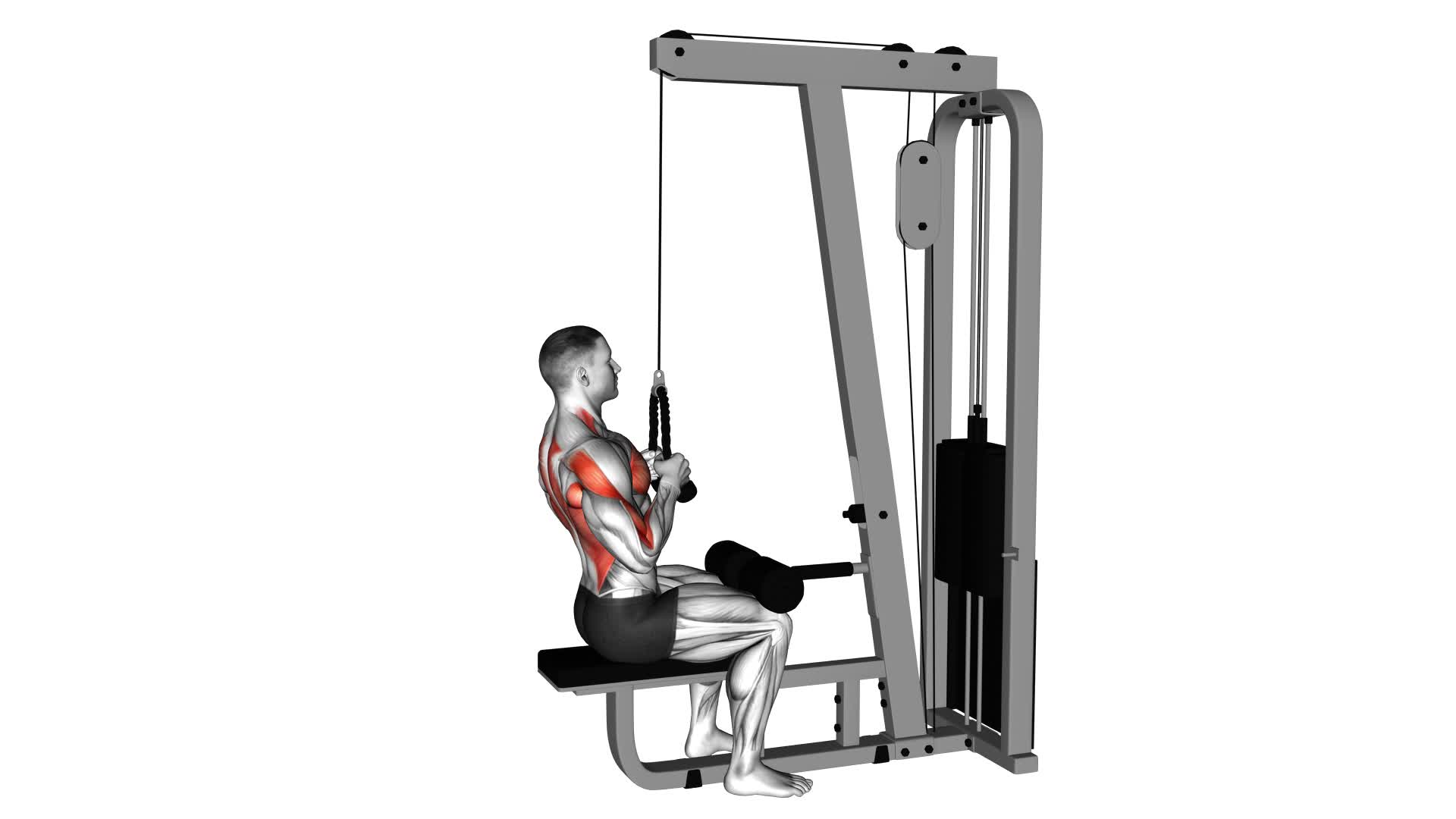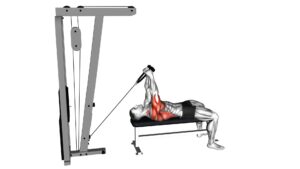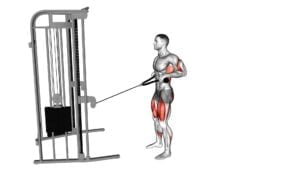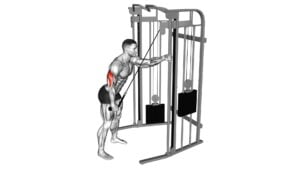Cable Lateral Pulldown (With Rope Attachment) – Video Exercise Guide & Tips

Looking to strengthen your upper body and improve your back muscles? The cable lateral pulldown with rope attachment is the perfect exercise for you.
Watch This Exercise Video
In this video exercise guide, we'll show you how to properly perform this exercise, along with tips for maximizing your results.
Whether you're a beginner or an experienced lifter, this exercise will help you achieve your fitness goals.
Get ready to challenge yourself and see the benefits of the cable lateral pulldown with rope attachment.
Key Takeaways
- Cable lateral pulldown with rope activates and strengthens back muscles, particularly the latissimus dorsi.
- This exercise engages biceps and forearms, leading to increased upper arm strength and definition.
- Cable lateral pulldown improves posture by strengthening back muscles and maintaining proper alignment.
- It enhances overall upper body strength and stability, benefiting other exercises like pull-ups and rows.
Benefits of Cable Lateral Pulldown With Rope
Discover the numerous benefits you can experience by incorporating the Cable Lateral Pulldown with Rope into your workout routine. This exercise is highly effective in activating and strengthening your back muscles. When performing the Cable Lateral Pulldown with Rope, you engage your latissimus dorsi, which is the largest muscle in your back. This muscle plays a crucial role in various pulling movements and contributes to a well-rounded physique.
In addition to targeting your back, this exercise also activates your biceps and forearms. As you pull the rope towards your body, you engage these muscles, leading to increased strength and definition in your upper arms.
Furthermore, the Cable Lateral Pulldown with Rope helps improve your posture. By strengthening your back muscles, you can alleviate the strain on your spine and maintain proper alignment. This can prevent common issues such as rounded shoulders and back pain.
Incorporating this exercise into your routine also promotes overall upper body strength and stability. By consistently performing the Cable Lateral Pulldown with Rope, you can enhance your pulling strength, which translates to improved performance in other exercises such as pull-ups and rows.
To maximize the benefits of this exercise, focus on proper form and controlled movements. Keep your back straight, engage your core, and pull the rope towards your chest while squeezing your shoulder blades together.
Equipment and Setup for the Exercise
To set up for the Cable Lateral Pulldown with Rope exercise, gather your equipment and attach the rope to the cable machine. For this exercise, you'll need a cable machine with a high pulley and a rope attachment. Make sure the cable machine is set at a height that allows you to fully extend your arms overhead.
To attach the rope to the cable machine, simply feed the end of the rope through the hole in the cable attachment and pull it through until it's secure. Make sure the rope is evenly distributed on both sides of the attachment.
Once the rope is attached, adjust the weight on the cable machine to your desired resistance level. Start with a lighter weight and gradually increase as you become more comfortable with the exercise.
Stand facing the cable machine and grasp the rope with an overhand grip. Step back a few feet to create tension in the cable. Your feet should be shoulder-width apart and your knees slightly bent.
Now you're ready to begin the Cable Lateral Pulldown with Rope exercise. Keep your core engaged and pull the rope down towards your hips, squeezing your shoulder blades together at the bottom of the movement. Slowly return the rope to the starting position and repeat for the desired number of repetitions.
Remember to maintain proper form throughout the exercise and avoid using momentum to complete the movement. Focus on engaging your back muscles and feeling the contraction with each repetition.
Proper Form and Technique
Use proper form and technique while performing the Cable Lateral Pulldown with Rope exercise to maximize results and minimize the risk of injury.
To begin, it's crucial to focus on the importance of breathing during the exercise. Take a deep breath in before you begin the movement, and exhale as you pull the rope down towards your chest. This will help you engage your core muscles and stabilize your body throughout the exercise.
To ensure optimal muscle activation, keep your back straight and your chest lifted throughout the movement. Avoid using momentum or swinging your body to complete the exercise. Instead, focus on squeezing your shoulder blades together as you pull the rope down towards your chest. This will activate your latissimus dorsi muscles, as well as your biceps and forearms.
Maintain a controlled and slow tempo throughout the exercise, both during the downward movement and the return to the starting position. This will allow you to fully engage your muscles and prevent any unnecessary strain or injury.
Now that you understand the proper form and technique for the Cable Lateral Pulldown with Rope exercise, let's move on to discussing variations and modifications that can help you customize your workout routine.
Variations and Modifications
Now let's explore some ways you can modify and vary the Cable Lateral Pulldown with Rope exercise to suit your fitness needs.
One way to modify this exercise is by using different rope attachments. Instead of the standard rope attachment, you can try using a V-bar attachment or a straight bar attachment. This will change the grip and target different muscles in your back and arms.
Another modification you can make is by adjusting the weight. If you want to increase the intensity, you can add more weight to challenge your muscles. On the other hand, if you're a beginner or recovering from an injury, you can decrease the weight or even use resistance bands instead of the cable machine.
If you're looking for alternative exercises, you can try the bent-over row or the seated cable row. These exercises also target the muscles in your back and arms and can provide a similar workout to the Cable Lateral Pulldown with Rope.
By modifying the rope attachment and exploring alternative exercises, you can keep your workouts interesting and continue to challenge your muscles.
Now, let's move on to the next section and discuss common mistakes to avoid when performing the Cable Lateral Pulldown with Rope exercise.
Common Mistakes to Avoid
One common mistake to avoid when performing the Cable Lateral Pulldown with Rope exercise is neglecting proper form. Proper execution is crucial for maximizing the effectiveness of this exercise and minimizing the risk of injury.
One mistake to avoid is using excessive momentum to pull the rope down. This can lead to a lack of control and reduce the engagement of the targeted muscles. Instead, focus on using a controlled and deliberate motion throughout the exercise.
Another mistake to avoid is rounding your back or hunching your shoulders. This can put unnecessary strain on your spine and limit the activation of your back muscles. Keep your back straight and your shoulders pulled back and down throughout the entire movement.
Additionally, avoid gripping the rope too tightly. This can cause excessive tension in your forearms and take away from the emphasis on your back muscles. Instead, maintain a relaxed but firm grip on the rope.
Tips for Maximizing Your Results
To maximize your results with cable lateral pulldowns, it's crucial to focus on proper form. By maintaining correct posture and engaging the targeted muscles, you can ensure maximum effectiveness of the exercise.
Additionally, utilizing the progressive overload technique, gradually increasing the weight or resistance over time, will stimulate muscle growth and strength.
Lastly, consistency and commitment to your workout routine will help you achieve the best results, so be sure to stay dedicated and make this exercise a regular part of your fitness regimen.
Proper Form Importance
Ensure proper form for optimal results during the cable lateral pulldown exercise. Proper form is crucial to maximize your results and minimize the risk of injuries. Here's why it's important:
- Muscle Activation: Maintaining correct form ensures that the targeted muscles are properly engaged during the exercise. This promotes muscle growth and strength development.
- Injury Prevention: Incorrect form can put unnecessary stress on joints and muscles, increasing the risk of strains, sprains, and other injuries. By following proper form, you can protect yourself from potential harm.
- Targeted Muscle Engagement: Proper form allows you to specifically target the muscles you want to work on. This helps you achieve your desired results more effectively.
- Efficient Workout: When you maintain proper form, you ensure that each repetition is performed correctly, maximizing the efficiency of your workout.
By emphasizing proper form, you lay the foundation for effective muscle activation and injury prevention.
Now, let's move on to the next section and explore the progressive overload technique.
Progressive Overload Technique
Maximize your results with the progressive overload technique during cable lateral pulldowns. Overload progression is a key component of this technique, which involves gradually increasing the demands placed on your muscles over time.
By progressively increasing the weight or resistance used during the exercise, you can continually challenge your muscles and promote further muscle activation. This technique helps to stimulate muscle growth and strength gains.
Start by selecting a weight that allows you to perform the exercise with proper form and control. As you become stronger, gradually increase the weight or resistance to keep challenging your muscles.
Remember to listen to your body and progress at a pace that's appropriate for you. By incorporating progressive overload, you can optimize your results from cable lateral pulldowns.
Consistency and Commitment
To maximize your results, it's crucial to maintain consistency and commitment throughout your cable lateral pulldown workouts. Here are some tips to help you stay on track:
- Set a schedule: Plan your workouts in advance and stick to a regular routine. This will help establish a habit and make it easier to stay consistent.
- Track your progress: Keep a record of your workouts, including the weight, sets, and reps. This will allow you to see your progress over time and provide motivation to keep going.
- Stay motivated: Find ways to stay motivated, such as setting goals, working out with a partner, or listening to music. Remember why you started and keep that in mind during your workouts.
- Be adaptable: Life can be unpredictable, so be prepared to make adjustments to your schedule if needed. If you miss a workout, don't get discouraged, just get back on track as soon as possible.
Frequently Asked Questions
How Many Sets and Reps Should I Do for Cable Lateral Pulldown With Rope?
To determine how many sets and reps you should do for cable lateral pulldown with rope, consider the cable lateral pulldown variations and the proper form for the exercise.
Cable lateral pulldown is a great exercise for targeting the muscles of your back and arms.
To get the most out of this exercise, aim for 3-4 sets of 8-12 reps. This will help build strength and muscle endurance in the target muscles.
Make sure to maintain proper form throughout the exercise to avoid injury and maximize results.
Can I Use a Different Attachment for the Cable Lateral Pulldown Instead of a Rope?
Yes, you can definitely use a different attachment for the cable lateral pulldown instead of a rope.
There are several alternatives to using a rope for this exercise. Some common attachments include straight bars, V-bars, and D-handles.
These different attachments can provide variations in grip and target different muscles in your back and shoulders.
Experiment with different attachments to find what works best for you and your fitness goals.
Is Cable Lateral Pulldown With Rope Suitable for Beginners?
If you're a beginner, starting with the cable lateral pulldown with a rope attachment can be a good choice. Using the rope attachment allows for a wider grip and can help target different muscles in your back.
However, it's important to listen to your body and start with lighter weights to avoid strain or injury.
As you build strength and confidence, you can gradually increase the weight and intensity of your workouts.
Will Cable Lateral Pulldown With Rope Help Me Build Bigger Biceps?
Yes, cable lateral pulldown with a rope attachment can help you build bigger biceps. This exercise targets your biceps and helps to increase their size and strength.
The rope attachment provides a different grip and angle, which can help to stimulate muscle growth.
It's a great alternative attachment for cable lateral pulldown, adding variety to your workout routine and allowing you to target your biceps in a different way.
Can I Do Cable Lateral Pulldown With Rope if I Have Shoulder or Back Pain?
If you have shoulder or back pain, it's important to modify your exercises for safety.
For the cable lateral pulldown with rope, you can try using lighter weights, reducing the range of motion, or using a different grip to alleviate stress on your shoulders and back.
Alternatively, you can consider other exercises such as seated rows, bent-over rows, or dumbbell rows that target the same muscles without putting as much strain on your shoulders and back.
Conclusion
In conclusion, the cable lateral pulldown with rope is an effective exercise for targeting the lateral muscles of the back.
By using proper form and technique, you can maximize your results and avoid common mistakes.
This exercise can be modified and varied to suit different fitness levels and goals.
Incorporating the cable lateral pulldown with rope into your workout routine can help improve back strength and overall upper body development.

Author
Years ago, the spark of my life’s passion ignited in my mind the moment I stepped into the local gym for the first time. The inaugural bead of perspiration, the initial endeavor, the very first surge of endorphins, and a sense of pride that washed over me post-workout marked the beginning of my deep-seated interest in strength sports, fitness, and sports nutrition. This very curiosity blossomed rapidly into a profound fascination, propelling me to earn a Master’s degree in Physical Education from the Academy of Physical Education in Krakow, followed by a Sports Manager diploma from the Jagiellonian University. My journey of growth led me to gain more specialized qualifications, such as being a certified personal trainer with a focus on sports dietetics, a lifeguard, and an instructor for wellness and corrective gymnastics. Theoretical knowledge paired seamlessly with practical experience, reinforcing my belief that the transformation of individuals under my guidance was also a reflection of my personal growth. This belief holds true even today. Each day, I strive to push the boundaries and explore new realms. These realms gently elevate me to greater heights. The unique combination of passion for my field and the continuous quest for growth fuels my drive to break new ground.







